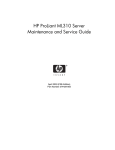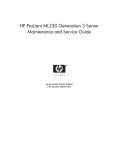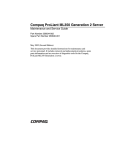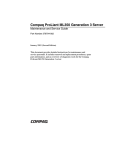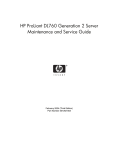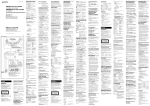Download Compaq ProLiant Specifications
Transcript
ProLiant ML330e/ML330 Server Maintenance and Service Guide Fourth Edition (March 2001) Part Number 174623-004 Spare Part Number 176670-001 Compaq Computer Corporation Notice © 2001 Compaq Computer Corporation Compaq, the Compaq logo, ROMPaq, Compaq Insight Manager, ProLiant, and QuickFind Registered in U.S. Patent and Trademark Office. SmartStart is a trademark of Compaq Information Technologies Group, L.P. in the United States and other countries. Microsoft, Windows, and Windows NT are trademarks of Microsoft Corporation in the United States and other countries. Intel and Pentium are trademarks of Intel Corporation in the United States and other countries. All other product names mentioned herein may be trademarks of their respective companies. Compaq shall not be liable for technical or editorial errors or omissions contained herein. The information in this document is provided “as is” without warranty of any kind and is subject to change without notice. The warranties for Compaq products are set forth in the express limited warranty statements accompanying such products. Nothing herein should be construed as constituting a further or additional warranty. Compaq ProLiant ML330e/ML330 Server Maintenance and Service Guide Fourth Edition (March 2001) Part Number 174623-004 Spare Part Number 176670-001 Contents About This Guide Symbols in Text........................................................................................................... v Important Safety Information .............................................................................. v Compaq Technician Notes ......................................................................................... vi Where to Go for Additional Help ..............................................................................vii Integrated Management Log ..............................................................................vii Telephone Numbers ...........................................................................................vii Chapter 1 Illustrated Parts Catalog Mechanical Parts Exploded View.............................................................................1-2 Mechanical Spare Parts List .....................................................................................1-3 System Components Exploded View .......................................................................1-4 System Components Spare Parts List .......................................................................1-5 Chapter 2 Removal and Replacement Procedures Electrostatic Discharge Information.........................................................................2-2 Symbols on Equipment ............................................................................................2-3 Preparation Procedures.............................................................................................2-4 Powering Down the Server................................................................................2-4 Server Warnings and Precautions......................................................................2-4 Front Bezel ...............................................................................................................2-5 Access Panel.............................................................................................................2-6 Storage Devices........................................................................................................2-7 Bezel Blanks......................................................................................................2-8 Drive Tray .........................................................................................................2-9 ATA Hard Drive Compartment (ProLiant ML330e Server) ...........................2-10 SCSI Hard Drive Compartment (ProLiant ML330 Server).............................2-12 Hard Drives .....................................................................................................2-14 Power Switch..........................................................................................................2-15 Fan..........................................................................................................................2-17 Cable Routing Diagrams ........................................................................................2-18 Processor with Heatsink .........................................................................................2-21 Memory Modules ...................................................................................................2-23 Removing a Memory Module ................................................................................2-25 Expansion Slots ......................................................................................................2-26 Server Feature Board..............................................................................................2-27 iv Compaq ProLiant ML330e/ML330 Server Maintenance and Service Guide Removal and Replacement Procedures continued Expansion Board Guide..........................................................................................2-28 System Board .........................................................................................................2-29 Power Supply .........................................................................................................2-30 Replacing a Battery ................................................................................................2-31 Replacing the System Board Battery...............................................................2-31 Replacing the Server Feature Board Battery ...................................................2-33 Chapter 3 Diagnostics Tools Diagnostics Tools Utility Overview .........................................................................3-2 For More Information...............................................................................................3-5 Chapter 4 Connectors, Switches, and LED Indicators Connectors................................................................................................................4-2 System Board Components ...............................................................................4-2 Rear Panel Connectors ......................................................................................4-4 Server Feature Board Components (ProLiant ML330e Server) ........................4-5 Server Feature Board Components (ProLiant ML330 Server)..........................4-6 Switches ...................................................................................................................4-7 Reserved Processor Switch Settings (SW1) ......................................................4-7 System Configuration Switch Settings (SW2) ..................................................4-8 Server Feature Board Switch Settings (SW1) ..........................................................4-9 Voltage Regulator Switch.......................................................................................4-10 LEDs.......................................................................................................................4-11 System Status LEDs ........................................................................................4-11 Network Controller LEDs ...............................................................................4-12 Chapter 5 Physical and Operating Specifications System Unit ..............................................................................................................5-2 Memory ....................................................................................................................5-3 1.44-MB Diskette Drive ...........................................................................................5-3 IDE CD-ROM Drive ................................................................................................5-4 ATA Hard Drives (ProLiant ML330e Server)..........................................................5-5 Wide Ultra2 SCSI Hard Drives (ProLiant ML330 Server) ......................................5-6 Integrated 10/100 Wake on LAN Network Interface Controller ..............................5-7 Integrated Single-Channel Wide Ultra2 SCSI Controller.........................................5-7 Integrated Ultra ATA 100 Controller .......................................................................5-8 Index About This Guide This maintenance and service guide is a troubleshooting guide that can be used for reference when servicing the Compaq ProLiant ML330e/ML330 server. WARNING: To reduce the risk of personal injury from electric shock and hazardous energy levels, only authorized service technicians should attempt to repair this equipment. Improper repairs can create conditions that are hazardous. Symbols in Text These symbols may be found in the text of this guide. They have the following meanings: WARNING: Text set off in this manner indicates that failure to follow directions in the warning can result in bodily harm or loss of life. CAUTION: Text set off in this manner indicates that failure to follow directions can result in damage to equipment or loss of information. IMPORTANT: Text set off in this manner presents clarifying information or specific instructions. NOTE: Text set off in this manner presents commentary, sidelights, or interesting points of information. Important Safety Information Before installing this product, read the Important Safety Information document provided. vi Compaq ProLiant ML330e/ML330 Server Maintenance and Service Guide Compaq Technician Notes WARNING: Only authorized technicians trained by Compaq can attempt to repair this equipment. All troubleshooting and repair procedures are detailed to allow only subassembly/module-level repair. Because of the complexity of the individual boards and subassemblies, no one should attempt to make repairs at the component level or to make modifications to any printed wiring board. Improper repairs can create a safety hazard. WARNING: To reduce the risk of personal injury from electric shock and hazardous energy levels, do not exceed the level of repair specified in these procedures. Because of the complexity of the individual boards and subassemblies, do not attempt to make repairs at the component level or to make modifications to any printed wiring board. Improper repairs can create conditions that are hazardous. WARNING: To reduce the risk of electric shock or damage to the equipment: ■ Disconnect power from the system by unplugging all power cords from the power supplies. ■ Do not disable the power cord grounding plug. The grounding plug is an important safety feature. ■ Plug the power cord into a grounded (earthed) electrical outlet that is easily accessible at all times. CAUTION: To properly ventilate the system, you must provide at least 7.6 cm (3.0 in.) of clearance at the front and back of the server. CAUTION: The server is designed to be electrically grounded (earthed). To ensure proper operation, plug the AC power cord into a properly grounded AC outlet only. NOTE: Any indications of component replacement or printed wiring board modifications may void any warranty. About This Guide Where to Go for Additional Help In addition to this guide, the following information sources are available: ■ User documentation ■ Compaq Service Quick Reference Guide ■ Service training guides ■ Compaq service advisories and bulletins ■ Compaq QuickFind™ information services ■ Compaq Insight Manager software Integrated Management Log The ProLiant ML330e/ML330 server includes an integrated, nonvolatile management log that contains fault and management information. The contents of the Integrated Management Log (IML) can be viewed with Compaq Insight Manager or the Web-based management tool, which is located on the Compaq Utilities tab of the browser-based management tool. Telephone Numbers For the name of your nearest Compaq authorized reseller: ■ In the United States, call 1-800-345-1518. ■ In Canada, call 1-800-263-5868. For Compaq technical support: ■ In the United States and Canada, call 1-800-OK COMPAQ. ■ For Compaq technical support phone numbers outside the United States and Canada, visit the Compaq website: http://www.compaq.com vii Chapter 1 Illustrated Parts Catalog This chapter provides the illustrated parts breakdown and spare parts lists for the Compaq ProLiant™ ML330e/ML330 server with an Intel Pentium III processor and a 133-MHz system bus. See Table 1-1 and Table 1-2 for the names of referenced spare parts. 1-2 Compaq ProLiant ML330e/ML330 Server Maintenance and Service Guide Mechanical Parts Exploded View 3a 2 3b 4b 1 4c 4a 5a Figure 1-1. Mechanical parts exploded view Illustrated Parts Catalog 1-3 Mechanical Spare Parts List Table 1-1 Mechanical Spare Parts List Item Description Spare Part Number Chassis 1 Chassis assembly 2 Front bezel 3 176605-001 ProLiant ML330e server 230542-001 ProLiant ML330 server 176604-001 Panel access left/right 176606-001 a) Hood panel (right) b) Access panel (left) Miscellaneous 4 Hardware kit 176618-001 a) Hard drive compartment b) Removable drive tray c) Expansion board knockout 5 Miscellaneous plastics kit a) Expansion board guide b) Rubber bumpers* c) Removable media bezel blank* d) Cable clips* e) Miscellaneous clamps* *Not shown 176617-001 1-4 Compaq ProLiant ML330e/ML330 Server Maintenance and Service Guide System Components Exploded View 13 6a 9 10 14 15 16a 7 11 12 8a 15 Figure 1-2. System components exploded view Illustrated Parts Catalog 1-5 System Components Spare Parts List Table 1-2 System Components Spare Parts List Item Description Spare Part Number Mass Storage Devices 6 IDE CD-ROM drive a) IDE CD-ROM drive x32 163354-001 b) IDE CD-ROM drive x40* 179963-001 7 Diskette drive 123958-001 8 Hard drive a) 20-GB ATA hard drive (ML330e model) 230699-001 b) 9.1-GB Wide Ultra2 hard drive (ML330 model)* 349534-001 System Components 9 Fan 10 PC 133-MHz ECC Registered SDRAM DIMM 176609-001 a) 64-MB* 159225-001 b) 128-MB* 159226-001 164278-001 c) 256-MB* 159304-001 159377-001 d) 512-MB* 159227-001 177628-001 Boards 11 12 System board ProLiant ML330e server 230540-001 ProLiant ML330 server 176615-001 Server Feature Board ProLiant ML330e server 230541-001 ProLiant ML330 server 176608-001 Power 13 CE Mark-compliant power supply 176616-001 *Not shown continued 1-6 Compaq ProLiant ML330e/ML330 Server Maintenance and Service Guide Table 1-2 System Components Spare Parts List continued Item 14 Description Spare Part Number Pentium III processor a) 667/133 with heatsink* 176610-001 b) 733/133 with heatsink* 176612-001 c) 800/133 with heatsink* (ProLiant ML330e and ML330) 176613-001 d) 866/133 with heatsink* 176614-001 e) 933/133 with heatsink* (ProLiant ML330e and ML330) 202350-001 f) 1-GHz/133 with heatsink* 217827-001 15 CR2032 lithium coin cell battery 234556-001 16 Power cable kit 176619-001 a) Power button assembly b) Power shield cable* c) Power extension cable* Miscellaneous 17 Enhanced keyboard* 386209-001 18 Signal cable kit* 176620-001 a) IDE ribbon cable assembly b) Diskette drive cable assembly c) Server Management Information Cable (SMIC) connector assembly 19 ATA cable assembly* 231702-001 20 Heatsink fan assembly* (for 1-GHz model only) 220997-001 21 Ultra2 SCSI cable* 176607-001 22 Country kit* 178196-001 23 Return kit* 176621-001 24 Maintenance and service guide* 176670-001 *Not shown Chapter 2 Removal and Replacement Procedures This chapter provides subassembly/module-level removal and replacement procedures for the Compaq ProLiant ML330e/ML330 server. Run the diagnostics program to verify that all components properly operate. To service the ProLiant ML330e/ML330 server, you might need the following: ■ Torx T-15 screwdriver ■ Phillips screwdriver ■ From the Compaq SmartStart™ and Support Software CD: GArray Diagnostics Utility (ADU) GDiagnostics software 2-2 Compaq ProLiant ML330e/ML330 Server Maintenance and Service Guide Electrostatic Discharge Information An electrostatic discharge (ESD) can damage static-sensitive devices or microcircuitry. Proper packaging and grounding techniques are necessary precautions to prevent damage. To prevent electrostatic damage, observe the following precautions: ■ Transport products in static-safe containers such as conductive tubes, bags, or boxes. ■ Keep electrostatic-sensitive parts in their containers until they arrive at static-free stations. ■ Cover workstations with approved static-dissipating material. Use a wrist strap connected to the work surface, and properly grounded (earthed) tools and equipment. ■ Keep work area free of nonconductive materials, such as ordinary plastic assembly aids and foam packing. ■ Make sure that you are always properly grounded when touching a static-sensitive component or assembly. ■ Avoid touching pins, leads, or circuitry. ■ Always place drives with the Printed Circuit Board (PCB) assembly-side down. ■ Use conductive field service tools. Removal and Replacement Procedures Symbols on Equipment These symbols may be located on equipment in areas where hazardous conditions may exist. This symbol, in conjunction with any of the following symbols, indicates the presence of a potential hazard. The potential for injury exists if warnings are not observed. This symbol indicates the presence of hazardous energy circuits or electric shock hazards. Refer all servicing to qualified personnel. WARNING: To reduce the risk of injury from electric shock hazards, do not open this enclosure. Refer all maintenance, upgrades, and servicing to qualified personnel. This symbol indicates the presence of electric shock hazards. The area contains no user- or field-serviceable parts. Do not open for any reason. WARNING: To reduce the risk of injury from electric shock hazards, do not open this enclosure. This symbol, on an RJ-45 receptacle, indicates a network interface connection. WARNING: To reduce the risk of electric shock, fire, or damage to the equipment, do not plug telephone or telecommunications connectors into this receptacle. This symbol indicates the presence of a hot surface or hot component. If this surface is contacted, the potential for injury exists. WARNING: To reduce the risk of injury from a hot component, allow the surface to cool before touching it. These symbols, on power supplies or systems, indicate that the equipment is supplied by multiple sources of power. WARNING: To reduce the risk of injury from electric shock, remove all power cords to completely disconnect power from the system. This symbol indicates that the component exceeds the recommended weight for one individual to safely handle. WARNING: To reduce the risk of personal injury or damage to the equipment, observe Weight in kg local occupational health and safety requirements and guidelines for manual material Weight in lb handling. 2-3 2-4 Compaq ProLiant ML330e/ML330 Server Maintenance and Service Guide Preparation Procedures WARNING: Only authorized technicians trained by Compaq should attempt to repair this equipment. Because of the complexity of the individual boards and subassemblies, no one should attempt to make repairs at the component level or to make modifications to any printed wiring board. Improper repairs can create a safety hazard. CAUTION: Electrostatic discharge (ESD) can damage electronic components. Be sure that you are properly grounded (earthed) before beginning any installation procedure. See “Electrostatic Discharge Information” earlier in this chapter for more information. Powering Down the Server Before beginning any removal and replacement procedure: 1. Open the drive bay door on the front bezel. 2. Power down the ProLiant ML330e/ML330 server by pressing the power button on the front of the server. IMPORTANT: To completely remove all power from the ProLiant ML330e/ML330 server, you must disconnect the power cord. The front panel power button may not completely shut down power to the server. 3. Disconnect and remove the AC power cord from the AC outlet, and then from the ProLiant ML330e/ML330 server. 4. Disconnect any other external equipment connections to the server. Server Warnings and Precautions WARNING: To reduce the risk of injury from electric shock, disconnect all power cords to completely remove power from the system. WARNING: To reduce the risk of personal injury from hot surfaces, allow the internal system components to cool before touching them. CAUTION: Protect the server from power fluctuations and temporary interruptions with a regulating uninterruptible power supply (UPS). This device protects the hardware from damage caused by power surges and voltage spikes, and keeps the system in operation during a power failure. CAUTION: The ProLiant ML330e/ML330 server must always be operated with system unit covers on. Proper cooling is not achieved when the system unit covers are removed. Removal and Replacement Procedures Front Bezel WARNING: To reduce the risk of personal injury and to prevent damage to the equipment, before removing the front bezel, make sure that the server is powered down, all cables are disconnected from the back of the server, and the power cord is disconnected from the grounded (earthed) AC outlet. To remove the front bezel: 1. Complete the preparation procedures. See “Preparation Procedures” earlier in this chapter. 2. Pull forward on the latch at the bottom of the front bezel . 3. Swing the front bezel upward, and then slide it out and away from the chassis . 1 2 Figure 2-1. Removing the front bezel NOTE: When replacing the front bezel, ensure that the top hinge points are properly placed in the chassis before rotating the front bezel back into its original position. NOTE: Intruder Alert enables and disables the intruder alert option. When enabled, an intruder alert message is displayed if the front bezel has been unlatched or removed. The default setting is disabled. To replace the front bezel, reverse steps 2 and 3. 2-5 2-6 Compaq ProLiant ML330e/ML330 Server Maintenance and Service Guide Access Panel WARNING: To reduce the risk of personal injury from hot surfaces, allow the internal system components to cool before touching them. WARNING: To reduce the risk of personal injury and to prevent damage to the equipment, before removing the access panel, make sure that the server is powered down, all cables are disconnected from the back of the server, and the power cord is disconnected from the grounded (earthed) AC outlet. CAUTION: Do not operate the server while the large access panel is removed. This panel is an integral part of the cooling system, and removing the panel while the system is running may adversely affect data integrity. To remove the access panel: 1. Perform the preparation procedures. See “Preparation Procedures” earlier in this chapter. 2. Remove the front bezel. See “Front Bezel” earlier in this chapter. 3. Remove the screw located on the left side of the front chassis . 4. Slide the access panel forward, pull from the top of the access panel, and then lift the panel from the chassis . 2 1 Figure 2-2. Removing the access panel NOTE: Turn the access panel over to locate the System Configuration Label. This label provides information about the system board on your ProLiant ML330e/ML330 server. To replace the access panel, reverse steps 2 through 4. Removal and Replacement Procedures Storage Devices The ProLiant ML330e/ML330 server ships standard with seven drive bays, five of which are available. Figure 2-3 shows the location of the storage devices. Table 2-1 shows the corresponding drive bay descriptions. 1 2 3 4 5 6 7 Figure 2-3. Storage device drive bay locations Table 2-1 Storage Device Drive Bay Descriptions Drive Position Description 5.25-inch x 1.6-inch IDE CD-ROM drive bay 5.25-inch x 1.6-inch available removable media drive bay 5.25-inch x 1.6-inch available removable media drive bay 5.25-inch x 1.6-inch available removable media drive bay 3.5-inch x 1-inch 1.44-MB diskette drive bay 3.5-inch x 1-inch hard drive bay 3.5-inch x 1-inch hard drive bay 2-7 2-8 Compaq ProLiant ML330e/ML330 Server Maintenance and Service Guide Bezel Blanks To remove a bezel blank from the front bezel: WARNING: To reduce the risk of personal injury and to prevent damage to the equipment, before removing the front bezel, make sure that the server is powered down, all cables are disconnected from the back of the server, and the power cord is disconnected from the grounded AC outlet. 1. Remove the front bezel. See “Front Bezel” earlier in this chapter. 2. On the back of the front bezel, pinch the tabs on either end of the bezel blank toward each other , and then push the bezel blank through the front bezel . 1 2 Figure 2-4. Removing a bezel blank To replace a bezel blank, reverse steps 1 and 2. 1 Removal and Replacement Procedures Drive Tray To remove a drive tray from a removable media bay: WARNING: To reduce the risk of personal injury and to prevent damage to the equipment, before removing the access panel, make sure that the server is powered down, all cables are disconnected from the back of the server, and the power cord is disconnected from the grounded (earthed) AC outlet. NOTE: The drive trays in the removable media bays can be used to mount internal 3.5-inch hard drives. 1. Complete the preparation procedures. See “Preparation Procedures” earlier in this chapter. 2. Remove the front bezel. See “Front Bezel” earlier in this chapter. 3. Remove the access panel. See “Access Panel” earlier in this chapter. 4. Remove the screws on either side of the drive tray out of the front of the chassis . , and then gently slide the drive tray 2 1 Figure 2-5. Removing a drive tray To replace a drive tray, reverse steps 2 through 4. 1 2-9 2-10 Compaq ProLiant ML330e/ML330 Server Maintenance and Service Guide ATA Hard Drive Compartment (ProLiant ML330e Server) To remove an ATA hard drive compartment from the ProLiant ML330e server: 1. Complete the preparation procedures. See “Preparation Procedures” earlier in this chapter. 2. Remove the front bezel door. See “Front Bezel” earlier in this chapter. 3. Remove the access panel. See “Access Panel” earlier in this chapter. 4. Disconnect all power and data cables from the back of all drives mounted in the hard drive compartment being removed. Figure 2-6. Disconnecting power and data cables from the ATA hard drive compartment Removal and Replacement Procedures 5. Remove the three shipping screws , squeeze the two spring clips drive compartment from the chassis . , and then pull the 2 2 3 1 1 Figure 2-7. Removing an ATA hard drive compartment To replace an ATA hard drive compartment, reverse steps 2 through 5. 2-11 2-12 Compaq ProLiant ML330e/ML330 Server Maintenance and Service Guide SCSI Hard Drive Compartment (ProLiant ML330 Server) To remove a SCSI hard drive compartment from the ProLiant ML330 server: 1. Complete the preparation procedures. See “Preparation Procedures” earlier in this chapter. 2. Remove the front bezel door. See “Front Bezel” earlier in this chapter. 3. Remove the access panel. See “Access Panel” earlier in this chapter. 4. Disconnect all power and data cables from the back of all drives mounted in the hard drive compartment being removed. Figure 2-8. Disconnecting power and data cables from the SCSI hard drive compartment Removal and Replacement Procedures 5. Remove the three shipping screws , squeeze the two spring clips drive compartment from the chassis . , and then pull the 2 2 3 1 1 Figure 2-9. Removing a SCSI hard drive compartment To replace a SCSI hard drive compartment, reverse steps 2 through 5. 2-13 2-14 Compaq ProLiant ML330e/ML330 Server Maintenance and Service Guide Hard Drives To remove a hard drive from the hard drive compartment: 1. Complete the preparation procedures. See “Preparation Procedures” earlier in this chapter. 2. Remove the front bezel. See “Front Bezel” earlier in this chapter. 3. Remove the access panel. See “Access Panel” earlier in this chapter. 4. Disconnect all the power and data cables from the back of all drives on the hard drive compartment. 5. Remove the two screws on each side of the drive . 6. Gently slide the drive out from the front of the hard drive compartment 1 1 2 Figure 2-10. Removing a hard drive To replace the hard drive, reverse steps 2 through 6. . Removal and Replacement Procedures Power Switch IMPORTANT: To completely remove all power from the system, you must disconnect the power cord from the server. To remove the power switch: 1. Complete the preparation procedures. See “Preparation Procedures” earlier in this chapter. 2. Remove the front bezel. See “Front Bezel” earlier in this chapter. 3. Remove the access panel. See “Access Panel” earlier in this chapter. 4. Disconnect the power switch cable from the system board. Figure 2-11. Disconnecting the power switch cable from the system board 2-15 2-16 Compaq ProLiant ML330e/ML330 Server Maintenance and Service Guide 5. From the front of the chassis, squeeze the sides of the power switch to disengage the two retainer clips from the chassis , and then gently remove the power switch from the chassis . 6. Also from the front of the chassis, squeeze the side of the LED to disengage the two retainer clips from the chassis , and then gently remove the LED from the chassis . 1 1 2 4 3 Figure 2-12. Removing the power switch and LED To replace the power switch and LED, reverse steps 2 through 6. Removal and Replacement Procedures Fan To remove the fan: 1. Complete the preparation procedures. See “Preparation Procedures” earlier in this chapter. 2. Remove the front bezel. See “Front Bezel” earlier in this chapter. 3. Remove the access panel. See “Access Panel” earlier in this chapter. 4. Disconnect the fan power cable from the system board fan connector . 5. Use a Phillips screwdriver to remove the four mounting screws from the rear of the server . 6. Pull the fan out and away from the chassis . 2 3 1 Figure 2-13. Removing the fan To replace the fan, reverse steps 2 through 6. 2-17 2-18 Compaq ProLiant ML330e/ML330 Server Maintenance and Service Guide Cable Routing Diagrams Figure 2-14 through Figure 2-18 show cable routing diagrams for the ProLiant ML330e/ML330 server. 1 2 Figure 2-14. Diskette drive cable and IDE CD-ROM drive cable routing Table 2-2 Diskette Drive Cable and IDE CD-ROM Drive Cable Routing Item Description Diskette drive cable IDE CD-ROM drive cable Removal and Replacement Procedures Figure 2-15. Server Management Information Cable (SMIC) routing (ProLiant ML330e server) Figure 2-16. Server Management Information Cable (SMIC) routing (ProLiant ML330 server) 2-19 2-20 Compaq ProLiant ML330e/ML330 Server Maintenance and Service Guide Figure 2-17. ATA cable routing (ProLiant ML330e server) Figure 2-18. Integrated Wide Ultra2 SCSI cable routing (ProLiant ML330 server) Removal and Replacement Procedures Processor with Heatsink To remove a processor with heatsink: CAUTION: Electrostatic discharge (ESD) can damage electronic components. Be sure that you are properly grounded (earthed) before beginning any installation procedure. See “Electrostatic Discharge Information” earlier in this chapter for more information. WARNING: To reduce the risk of personal injury from hot surfaces, allow the internal system components to cool before touching them. 1. Complete the preparation procedures. See “Preparation Procedures” earlier in this chapter. 2. Remove the front bezel. See “Front Bezel” earlier in this chapter. 3. Remove the access panel. See “Access Panel” earlier in this chapter. 4. Unplug the processor fan from the system board. Figure 2-19. Unplugging the processor fan from the system board 2-21 2-22 Compaq ProLiant ML330e/ML330 Server Maintenance and Service Guide 5. Press down and release the heatsink retainer clip to disengage one side from the processor socket . 6. Unhook the opposite side of the heatsink retainer clip from the processor socket then lift the heatsink/fan assembly from the processor socket . , and 7. Lift the lever, located on the side of the processor socket, to release the pins of the processor , and then pull the processor from the socket . 1 4 5 3 2 Figure 2-20. Removing the processor with heatsink To replace the processor with heatsink, reverse steps 2 through 7. IMPORTANT: The processor is keyed to ensure correct alignment. Removal and Replacement Procedures Memory Modules The ProLiant ML330e/ML330 server supports 64-, 128-, 256-, or 512-MB PC 133-MHz Registered error checking and correcting (ECC) synchronous dynamic random access memory (SDRAM) dual inline memory modules (DIMMs). CAUTION: Electrostatic discharge (ESD) can damage electronic components. Be sure that you are properly grounded (earthed) before beginning any installation procedure. See “Electrostatic Discharge Information” earlier in this chapter for more information. CAUTION: When handling a memory module, be careful not to touch any of the contacts. Doing so may damage the module. The following guidelines must be followed when installing or replacing memory: ■ Use only 64-, 128-, 256-, or 512-MB PC 133-MHz Registered ECC SDRAM DIMMs. ■ Memory modules must be industry-standard, 168-pin, PC 133-MHz Registered SDRAM DIMMs. The SDRAM DIMMs must support CAS Latency 3 (CL=3). ■ Do not mix ECC and non-ECC SDRAM DIMMs. If different types of memory modules are mixed, the system does not properly function. 2-23 2-24 Compaq ProLiant ML330e/ML330 Server Maintenance and Service Guide NOTE: Memory modules do not need to be installed in pairs and can be installed in any available socket. 1 2 3 4 Figure 2-21. Memory module socket locations Table 2-3 Memory Module Socket Locations Item Description Socket 1 Socket 2 Socket 3 Socket 4 Removal and Replacement Procedures Removing a Memory Module To remove a memory module: 1. Complete the preparation procedures. See “Preparation Procedures” earlier in this chapter. 2. Remove the front bezel. See “Front Bezel” earlier in this chapter. 3. Remove the access panel. See “Access Panel” earlier in this chapter. 4. Press outward on both latches of the memory module socket at the same time releases the DIMM and pushes it partially out of the socket. 5. Lift the memory module from the socket . 1 2 Figure 2-22. Removing a memory module To replace a memory module, reverse steps 2 through 5. 1 . This step 2-25 2-26 Compaq ProLiant ML330e/ML330 Server Maintenance and Service Guide Expansion Slots 1 2 3 4 5 6 Figure 2-23. Expansion slot locations Table 2-4 Expansion Slots Item Description Slot Number 64-bit PCI (half-length) 1 64-bit PCI 2 32-bit PCI (Server Feature Board) 3 32-bit PCI 4 32-bit PCI 5 32-bit PCI 6 Removal and Replacement Procedures Server Feature Board To remove a Server Feature Board: 1. Complete the preparation procedures. See “Preparation Procedures” earlier in this chapter. 2. Remove the front bezel. See “Front Bezel” earlier in this chapter. 3. Remove the access panel. See “Access Panel” earlier in this chapter. 4. Disconnect any cables connected to the Server Feature Board. 5. Remove the screw securing the Server Feature Board to the chassis Server Feature Board out of the server . 1 2 Figure 2-24. Removing the Server Feature Board NOTE: The Server Feature Board is located only in slot 3. To replace the Server Feature Board, reverse steps 2 through 5. , and then pull the 2-27 2-28 Compaq ProLiant ML330e/ML330 Server Maintenance and Service Guide Expansion Board Guide To remove the expansion board guide: 1. Complete the preparation procedures. See “Preparation Procedures” earlier in this chapter. 2. Remove the front bezel. See “Front Bezel” earlier in this chapter. 3. Remove the access panel. See “Access Panel” earlier in this chapter. 4. Remove all expansion boards supported by the board guide. 5. Push in the four locking tabs chassis . , and then pull the guide back and away from the 1 1 1 2 1 Figure 2-25. Removing the expansion board guide To replace the expansion board guide, reverse steps 2 through 5. Removal and Replacement Procedures System Board CAUTION: Electrostatic discharge (ESD) can damage electronic components. Be sure that you are properly grounded (earthed) before beginning any installation procedure. See “Electrostatic Discharge Information” earlier in this chapter for more information. To remove the system board: 1. Complete the preparation procedures. See “Preparation Procedures” earlier in this chapter. 2. Remove the front bezel. See “Front Bezel” earlier in this chapter. 3. Remove the access panel. See “Access Panel” earlier in this chapter. 4. Remove all expansion boards seated on the system board. 5. Disconnect all cables from the system board. 6. Remove the ten screws securing the system board to the chassis 7. Pull the system board out of the chassis . 2 1 Figure 2-26. Removing the system board To replace the system board, reverse steps 2 through 7. . 2-29 2-30 Compaq ProLiant ML330e/ML330 Server Maintenance and Service Guide Power Supply To remove the power supply: WARNING: To reduce the risk of electric shock or damage to the equipment: ■ Unplug the power cord before removing the power supply from the server. ■ Install the power supply before connecting the power cord to the power supply. CAUTION: To avoid dropping the power supply, pull out and hold the power supply with a firm grip. 1. Complete the preparation procedures. See “Preparation Procedures” earlier in this chapter. 2. Remove the front bezel. See “Front Bezel” earlier in this chapter. 3. Remove the access panel. See “Access Panel” earlier in this chapter. 4. Remove the four screws securing the power supply to the rear of the chassis . 5. Slide the power supply forward, and then lift the power supply from the chassis 1 2 1 Figure 2-27. Removing the power supply To replace the power supply, reverse steps 2 through 5. . Removal and Replacement Procedures Replacing a Battery The ProLiant ML330e/ML330 server has nonvolatile memory, which requires a battery to retain system information. There is a battery on the system board and a battery on the Server Feature Board. These batteries are required to maintain certain system data. Replacing the System Board Battery If your server no longer automatically displays the correct date and time, you may need to replace the battery that provides power to the real-time clock. When replacing a battery, use a 3-volt CR2032 lithium coin cell battery. WARNING: The system board contains a lithium battery. There is a risk of fire and chemical burn if the battery is improperly handled. Do not disassemble, crush, puncture, or short external contacts, dispose of in water or fire, or expose the battery to temperatures higher than 60°C (140°F). CAUTION: Electrostatic discharge (ESD) can damage electronic components. Be sure that you are properly grounded (earthed) before beginning any installation procedure. See “Electrostatic Discharge Information” earlier in this chapter for more information. To replace the lithium coin cell battery from the system board: 1. Complete the preparation procedures. See “Preparation Procedures” earlier in this chapter. 2. Remove the front bezel. See “Front Bezel” earlier in this chapter. 3. Remove the access panel. See “Access Panel” earlier in this chapter. 2-31 2-32 Compaq ProLiant ML330e/ML330 Server Maintenance and Service Guide 4. Locate the battery on the system board, and then slide the battery out of the holder. 5. Slide the replacement battery into the proper position with the positive (+) side up. Figure 2-28. Locating and removing the battery from the system board IMPORTANT: Positive (+) polarity must be positioned up. 6. For the ProLiant ML330 server, run the BIOS Setup utility to reconfigure your system. 7. For the ProLiant ML330e server, run the ROM Based Setup Utility (RBSU) to reconfigure your system. Removal and Replacement Procedures Replacing the Server Feature Board Battery WARNING: The Server Feature Board contains a lithium battery. There is a risk of fire and chemical burn if the battery is improperly handled. Do not disassemble, crush, puncture, or short external contacts, dispose of in water or fire, or expose the battery to temperatures higher than 60°C (140°F). CAUTION: Electrostatic discharge (ESD) can damage electronic components. Be sure that you are properly grounded (earthed) before beginning any installation procedure. See “Electrostatic Discharge Information” earlier in this chapter for more information. To replace the lithium coin cell battery from the Server Feature Board: 1. Complete the preparation procedures. See “Preparation Procedures” earlier in this chapter. 2. Remove the front bezel. See “Front Bezel” earlier in this chapter. 3. Remove the access panel. See “Access Panel” earlier in this chapter. 4. Remove the Server Feature Board. See “Server Feature Board” earlier in this chapter. 5. Locate the battery on the Server Feature Board, and then slide the battery out of the holder. 6. Slide the replacement battery into the proper position with the positive (+) side up. Figure 2-29. Locating and removing the battery from the Server Feature Board IMPORTANT: Positive (+) polarity must be positioned up. 7. Replace the Server Feature Board, front panel, and bezel. 8. Connect the server and power up. 9. For the ProLiant ML330 server, run the BIOS Setup utility to reconfigure your system. 10. For the ProLiant ML330e server, run the RBSU to reconfigure your system. 2-33 Chapter 3 Diagnostics Tools This chapter provides an overview of the software and firmware diagnostics tools available for the Compaq ProLiant ML330e/ML330 server. 3-2 Compaq ProLiant ML330e/ML330 Server Maintenance and Service Guide Diagnostics Tools Utility Overview The following utilities were developed to assist in diagnosing problems, testing the hardware, and monitoring and managing the ProLiant ML330e/ML330 server hardware. Table 3-1 Diagnostics Tools Tool What it is How to run it Compaq Diagnostics Utility to assist testing and/or verifying operation of Compaq hardware. If problems are found, Compaq Diagnostics isolates failures down to the replaceable part whenever possible. Diagnostics and utilities must be accessed when a system configuration error is detected during Power-On Self-Test (POST). For a complete list of POST error messages, see the Compaq Servers Troubleshooting Guide. Compaq Diagnostics software is also available on the Compaq SmartStart and Support Software CD. A Diagnostics diskette can be created from the SmartStart and Support Software CD, and Diagnostics can then be run from the diskette. Compaq Inspect Utility The Inspect Utility provides a report detailing system inventory and configuration information. Run the Inspect Utility from the Compaq Diagnostics program. Compaq Insight TM Manager A client/server application used to remotely manage Compaq systems in a network environment. Reports hardware fault conditions (both failure and prefailure) and collects data for reporting and graphing. For more information, refer to the Compaq Management CD and the Compaq Insight Manager User Guide. Compaq Survey Utility An information-gathering program that runs on servers, gathering critical hardware and software information from various sources. A utility for servers running Microsoft Windows NT or Novell NetWare. Install the Survey Utility from SmartStart, the Compaq Integration Maintenance Utility, or the Compaq Management CD. If a significant change occurs between data-gathering intervals, previous information is marked, and the survey text file is overwritten to reflect the latest configuration and changes since the last configuration. This utility provides a historical record of change events for server hardware and software. continued Diagnostics Tools Table 3-1 Diagnostics Tools continued Tool What it is How to run it Compaq SmartStart Located on the SmartStart and Support Software CD, SmartStart is the intelligent way to set up your Compaq server. SmartStart includes the ROMPaq™ Utility, driver updates, and assisted operating system installations. Power up from the SmartStart and Support Software CD. Array Diagnostics Utility (ADU) A Windows-based tool designed to run on all Compaq systems that support Compaq array controllers. The main functions of ADU are to collect all possible information about the array controllers in the system and to generate a list of detected problems. Power up from the SmartStart and Support Software CD or use the Diskette Builder (also located on the CD) to create ADU bootable diskettes. A log of system events, such as system failures or nonfatal error conditions. View events from within: The IML requires Compaq operating system-dependent drivers. Refer to the Compaq Software Support CD for instructions on installing the appropriate drivers. Integrated Management Log BIOS Setup utility for the ProLiant ML330 server ■ Compaq Insight Manager ■ Compaq Survey Utility ■ OS-specific IML Utilities Utility used to configure the hardware installed in or connected to the server. Specifically, it can: ■ Configure PCI boards automatically ■ Manage installation of memory, processor upgrades, and mass storage devices such as hard drives, tape drives, and diskette drives ■ Store configuration information in nonvolatile memory ■ Assist in installation of an operating system Use the information provided in the ADU. For a complete list of ADU error messages, see the Compaq Servers Troubleshooting Guide. The BIOS Setup utility is loaded during POST if F10 is pressed. When “F10Setup” is displayed in the lower right corner of the screen, press F10 to initiate the utility. continued 3-3 3-4 Compaq ProLiant ML330e/ML330 Server Maintenance and Service Guide Table 3-1 Diagnostics Tools continued Tool What it is How to run it ROM Based Setup Utility (RBSU) for the ProLiant ML330e server Utility used to configure some hardware installed in or connected to the server. Specifically, it can: Run RBSU directly from the system ROM by pressing F9 when prompted during POST to enter the utility. Automatic Server Recovery (ASR) ■ Resolve resource conflicts in areas such as memory, port addresses, and interrupts (IRQs) ■ Configure PCI boards automatically ■ Provide switch and jumper settings ■ Manage installation of memory, processor upgrades, and mass storage devices such as hard drives, tape drives, and diskette drives ■ Store configuration information in nonvolatile memory ■ Configure the platform for an operating system A tool that lets the server restart automatically after a catastrophic operating system failure, including software errors, OS lockups, environmental abnormalities, and some hardware errors. This tool is a function of the hardware/software system through RBSU. Verify that this tool is enabled through RBSU. The systems management drive must be loaded to activate ASR. Unattended recovery logs the error information to the FRONT BEZEL:REMOVING, WARNING, resets the server, and tries to restart the operating system. ROMPaq Utility A utility that upgrades the current system ROM. Run from the ROMPaq diskette after powering up the system. SmartStart Diskette Builder Creates a diskette version of the utility from the SmartStart and Support Software CD. Run from the SmartStart and Support Software CD. Diagnostics Tools For More Information For detailed information about each of these diagnostics tools, see the Compaq Servers Troubleshooting Guide on the documentation CD. For the most recent version of this guide, go to the Compaq website: http://www.compaq.com 3-5 Chapter 4 Connectors, Switches, and LED Indicators This chapter contains illustrations and tables identifying connectors, switches, and LED locations on the rear panel, Server Feature Board, and system board for the Compaq ProLiant ML330e/ML330 server. 4-2 Compaq ProLiant ML330e/ML330 Server Maintenance and Service Guide Connectors This section contains graphics and tables identifying connector locations on the system board, rear panel, and Server Feature Board for the Compaq ProLiant ML330e/ML330 server. System Board Components 15 14 16 17 13 12 9 11 8 10 7 18 19 20 6 21 5 22 4 23 3 2 Figure 4-1. System board components 1 25 24 Connectors, Switches, and LED Indicators Table 4-1 System Board Components Item Description 32-bit PCI slot 6 32-bit PCI slot 5 32-bit PCI slot 4 32-bit PCI slot 3 (Server Feature Board) 64-bit PCI slot 2 64-bit PCI slot 1 (half-length) Battery System fan connector Processor Serial port connector B Parallel port connector Serial port connector A USB ports (ProLiant ML330e server only) Item Description Mouse connector Keyboard connector Power supply connector Diskette drive connector DIMM slots (four) Primary IDE connector Power button connector Server Management Information Cable (SMIC) connector Secondary IDE connector Remote Insight Lights-Out Edition board connector System configuration switch (SW2) Reserved processor switch (SW1) IMPORTANT: Power for the Remote Insight Lights-Out Edition board must come from the external power supply of the Remote Insight Lights-Out Edition board and not from the system board. 4-3 4-4 Compaq ProLiant ML330e/ML330 Server Maintenance and Service Guide Rear Panel Connectors 1 2 3 4 5 6 7 8 9 Figure 4-2. Rear panel connectors Table 4-2 Rear Panel Connectors Item Description Power cord Voltage selector switch Mouse Keyboard USB port (ProLiant ML330e server only) Item Description Serial ports Parallel port RJ-45 Ethernet for NIC Video Connectors, Switches, and LED Indicators Server Feature Board Components (ProLiant ML330e Server) 2 1 3 9 8 4 7 6 5 Figure 4-3. Server Feature Board components (ProLiant ML330e server) Table 4-3 Server Feature Board Components (ProLiant ML330e Server) Item Description ATA channel connector Server Management Information Cable (SMIC) connector Server Feature Board configuration switch Replaceable lithium coin cell battery (CR2032) RJ-45 Ethernet connector for NIC Item Description Video connector Network speed indicator Network link indicator Network activity indicator 4-5 4-6 Compaq ProLiant ML330e/ML330 Server Maintenance and Service Guide Server Feature Board Components (ProLiant ML330 Server) 2 1 9 3 8 4 7 6 5 Figure 4-4. Server Feature Board components (ProLiant ML330 server) Table 4-4 Server Feature Board Components (ProLiant ML330 Server) Item Description SCSI channel connector Server Management Information Cable (SMIC) connector Server Feature Board configuration switch Replaceable lithium coin cell battery (CR2032) RJ-45 Ethernet connector for NIC Item Description Video connector Network speed indicator Network link indicator Network activity indicator Connectors, Switches, and LED Indicators Switches This section contains graphics and tables showing switch locations on the ProLiant ML330e/ML330 server system board and Server Feature Board. Reserved Processor Switch Settings (SW1) on 1 2 3 4 Figure 4-5. Reserved processor switch settings (SW1) Table 4-5 Reserved Processor Switch Settings (SW1) Switch Default Description 1 Off Reserved 2 Off Reserved 3 Off Reserved 4 Off Reserved 4-7 4-8 Compaq ProLiant ML330e/ML330 Server Maintenance and Service Guide System Configuration Switch Settings (SW2) on 1 2 3 4 Figure 4-6. System configuration switch settings (SW2) Table 4-6 System Configuration Switch Settings (SW2) Switch 1 Default Function Description Settings Off Clear/set up password Used to disable password Off = Password enabled On = Password disabled 2 3 4 Off Off Off Clear CMOS and NVRAM Used to clear system configuration settings Off = Normal ROMPaq disaster recovery enable Used to enable ROMPaq disaster recover mode when system ROM is corrupted Off = Normal server operations mode Reserved On = When server is powered up, all system configuration information is erased. On = ROMPaq disaster recovery mode Connectors, Switches, and LED Indicators Server Feature Board Switch Settings (SW1) on 1 2 3 4 5 6 7 8 Figure 4-7. Server Feature Board switch settings (SW1) Table 4-7 Server Feature Board Switch Settings (SW1) Switch 1 Default Function Description Settings Off Enable embedded video Used to disable the onboard video controller when an optional video adapter is installed. Off = Embedded video is enabled 2 Off Reserved 3 Off Reserved 4 Off Reserved 5 Off Reserved 6 Off Reserved 7 Off Reserved 8 Off Reserved On = Embedded video is disabled IMPORTANT: Positions 2 through 8 are reserved for Compaq authorized service providers only. Do not change these switches from the indicated default settings. NOTE: For information on troubleshooting video problems, refer to “Video Problems” in the Compaq Servers Troubleshooting Guide. 4-9 4-10 Compaq ProLiant ML330e/ML330 Server Maintenance and Service Guide Voltage Regulator Switch Set the voltage regulator switch to either 115 volts or 230 volts, as appropriate for your location. 115 230 Figure 4-8. Voltage regulator switch location Connectors, Switches, and LED Indicators LEDs This section contains graphics information on the following LEDs: ■ System status LEDs ■ Network controller status LEDs System Status LEDs 1 2 3 Figure 4-9. System status power button LEDs Table 4-8 System Status LEDs Item Power button Power status Hard drive activity status Status Description System on On System on, AC power OK. Do not remove power from system. On or off System off, no AC power Off Drive being accessed On or flashing Drive not being accessed Off 4-11 4-12 Compaq ProLiant ML330e/ML330 Server Maintenance and Service Guide Network Controller LEDs 1 2 3 Figure 4-10. Network controller LEDs Table 4-9 Network Controller LEDs Item Description Status Condition Speed Off 10Base-T 10-Mbps (10Base-T Ethernet) On 100Base-TX 100-Mbps (100Base-TX Ethernet) Off No network link On Linked to network Off No network activity On or flashing Network activity Link Activity Chapter 5 Physical and Operating Specifications This chapter provides specifications for the Compaq ProLiant ML330e/ML330 server. The following specifications are provided: ■ System Unit ■ Memory ■ 1.44-MB Diskette Drive ■ IDE CD-ROM Drive ■ Wide Ultra2 SCSI Hard Drives for the ProLiant ML330 Server ■ ATA Hard Drives for the ProLiant ML330e Server ■ Integrated 10/100 Wake on LAN Network Interface Controller (NIC) ■ Integrated Single-Channel Wide Ultra2 SCSI Controller ■ Integrated Ultra ATA 100 Controller 5-2 Compaq ProLiant ML330e/ML330 Server Maintenance and Service Guide System Unit Table 5-1 System Unit Specifications Dimensions Height 42.86 mm (16.88 in) Width 19.05 mm (7.5 in) Depth 50.8 mm (20 in) Weight 10.1 kg (26 lb) weight approximate, depending upon options International input requirements Rated input voltage 180 VAC to 264 VAC Rated input frequency 50 Hz to 60 Hz Rated input current 3A U.S. input requirements Rated input voltage 90 VAC to 132 VAC Rated input frequency 50 Hz to 60 Hz Rated input current 6A Power supply output power Rated steady state power BTUs for tower model CE Mark-compliant 1,560 Temperature range Operating 10°C to 35°C/50°F to 93°F Nonoperating -30°C to 60°C /-22°F to 140°F Relative humidity (noncondensing) Operating 20% to 80% Nonoperating 5% to 90% Acoustic noise Idle (hard drives spinning) 6 NPEL (Bels)/43 AVERAGE SPL (dba) Operating (random seeks to hard drives) 6.1 NPEL (Bels)/44 AVERAGE SPL (dba) Physical and Operating Specifications Memory Table 5-2 Memory Specifications Size 64-, 128-, 256-, and 512-MB, and 1-GB Speed PC 133-MHz Type ECC Registered SDRAM DIMMs 1.44-MB Diskette Drive Table 5-3 1.44-MB Diskette Drive Specifications Size 8.89 mm (3.5 in) LED indicators (front panel) Green Read/write capacity per diskette (high/low density) 1.44 MB/720 KB Drives supported 1 Drive height Third, 1 inch Drive rotation 300 rpm Transfer rate bits/sec (high/low) 500 Kbps/250 Kbps Bytes/sector 512 Sectors per rack (high/low) 18/9 Tracks per side (high/low) 80/80 Access times Track-to-track (high/low) 3 ms/6 ms Average (high/low) 169 ms/94 ms Settling time 15 ms Latency average 100 ms Cylinders (high/low) 80/80 Read/write heads 2 5-3 5-4 Compaq ProLiant ML330e/ML330 Server Maintenance and Service Guide IDE CD-ROM Drive Table 5-4 IDE CD-ROM Specifications Applicable disk CD-ROM (modes 1 and 2); mixed mode (audio and data combined); CD-DA; Photo CD (single- and multiple-session), CD-XA (mode 2, forms 1 and 2); CDI ready; CD-WO Capacity 650 MB Rotational speed 5,200 rpm Block size 2,328 bytes (CD-XA) 2,340, 2,336, 1,024 bytes (mode 2) 2,048, 1,024 bytes (mode 1) 2,352 bytes (CD-DA) Dimensions Height 42.9 mm (1.69 in) Width 208.0 mm (8.2 in) Depth 150.1 mm (5.91 in) Weight 0.950 kg (2.09 lb) Data transfer rate Sustained 150 KBps (single), 1,500 to 4,800 KBps (10X to 32X) Burst 150 KBps to 4,800 KBps Interface IDE (ATAPI) Access times (typical) Full stroke <150 ms Random <100 ms Diameter 12 cm, 8 cm (4.7 in, 3.15 in) Center hole 15 mm (0.6 in) Thickness 1.2 mm (0.05 inch) Track pitch 1.6 µm Cache/buffer 128 KB Startup time <7 seconds Stop time <4 seconds continued Physical and Operating Specifications Table 5-4 IDE CD-ROM Specifications continued Laser parameters Type Semiconductor Laser GaA1As Wave length 780 ± 25 nm Divergence angle 53.5° ± 1.5° Output power 0.14 mW Operating conditions Temperature 5°C to 45°C (41°F to 113°F) Humidity 5% to 90% (10% to 80%) ATA Hard Drives (ProLiant ML330e Server) Table 5-5 ATA Hard Drive (ProLiant ML330e Server) Specifications 20 GB 7.2K rpm Capacity 20,020.0 MB Height 25.4 mm (1 in) Width 88.9 mm (3.5 in) Interface ATA 100 16-bit Transfer rate synchronous (max) 100 MBps Seek time (typical, including setting) Single track 1.0 ms Average <8.7 ms Full stroke <20.0 ms Rotational speed 7,200 rpm Physical configuration Bytes/sector 512 Operating temperature Celsius 10° to 35° Fahrenheit 59° to 95° 5-5 5-6 Compaq ProLiant ML330e/ML330 Server Maintenance and Service Guide Wide Ultra2 SCSI Hard Drives (ProLiant ML330 Server) Table 5-6 Wide Ultra2 SCSI Hard Drive (ProLiant ML330 Server) Specifications 9.1 GB 7.2 K rpm 9.1 GB 10 K rpm Capacity 9,100.0 MB 9,100.0 MB Height 25.4 mm (1 in) 25.4 mm (1 in) Width 88.9 mm (3.5 in) 88.9 mm (3.5 in) Interface Wide Ultra2 SCSI Wide Ultra2 SCSI Transfer rate synchronous (max) 80 MBps 80 MBps Single track 1.9 ms 0.8 ms Average 7.5 ms 5.4 ms Full stroke 15.0 ms 12.2 ms Rotational speed 7,200 rpm 10,000 rpm Bytes/sector 512 512 Logical blocks 17,773,524 17,773,524 Celsius 10° to 35° 10° to 35° Fahrenheit 59° to 95° 59° to 95° Seek time (typical, including setting) Physical configuration Operating temperature Physical and Operating Specifications Integrated 10/100 Wake on LAN Network Interface Controller Table 5-7 Integrated 10/100 Wake on LAN NIC Specifications Network interface 10Base-T/100Base-TX Compatibility IEEE 802.2, 802.3, 802.3u Data transfer method 32-bit, PC 33-MHz bus master Network transfer rate 10/100 Mbps Connector RJ-45 I/O address and interrupt Plug and Play PCI Compliance PCI 2.2 and 2.1 OS support (ProLiant ML330 server) Microsoft Windows NT 4.0, Microsoft Windows NT server 4.0, Microsoft Windows 2000 Server, Terminal Server Edition 4.01, Red Hat Linux, SuSE Linux, TurboLinux, Caldera OpenLinux eServer, Novell NetWare 3.2, 4.2, 5.0, 5.1, Novell Small Business Suite 4.2, 5.0, SCO OpenServer 5.05, SCO UnixWare 7.1, 7.1.1 OS support (ProLiant ML330e server) Microsoft Windows NT 4.0, Microsoft Windows NT server 4.0, Microsoft Windows 2000 Server (when available), Terminal Server Edition 4.01, Microsoft Small Business Server 2000, Red Hat Linux, SuSE Linux, TurboLinux, Caldera OpenLinux eServer, Integrated Single-Channel Wide Ultra2 SCSI Controller Table 5-8 Integrated Single-Channel Wide Ultra2 SCSI Controller Specifications Protocol Wide Ultra2 SCSI Compatibility All PCI server configurations are backward compatible with Wide Ultra2 SCSI devices Drives supported Up to 7 SCSI devices per channel Data transfer method 32-bit PCI bus-master Maximum transfer rate per PCI Bus (peak) 133 MBps SCSI channel transfer rate 80 MBps per channel SCSI termination Active termination SCSI connectors 1 internal 5-7 5-8 Compaq ProLiant ML330e/ML330 Server Maintenance and Service Guide Integrated Ultra ATA 100 Controller Table 5-9 Integrated Ultra ATA 100 Controller Specifications Protocol Ultra ATA 100 Drives supported Up to 2 ATA devices per channel Data transfer method 32-bit PCI bus-master Maximum transfer rate per PCI Bus (peak) 133 MBps ATA channel transfer rate 100 MBps per channel ATA connectors 2 internal Index A access panel part number 1-3 removing 2-6 caution 2-6 illustrated 2-6 warning 2-6, 2-9 replacing 2-6 access times CD-ROM drive 5-4 diskette drive 5-3 ADU (Array Diagnostics Utility) described 3-3 locating 2-1 Array Diagnostics Utility See ADU ASR (Automatic Server Recovery, running 3-4 ATA (ProLiant ML330e server), cable routing, illustrated 2-20 ATA cable assembly, part number 1-6 ATA hard drive compartment removing 2-10, 2-11 removing cables, illustrated 2-10 removing, illustrated 2-11 replacing 2-11 Automatic Server Recovery See ASR B battery function of 2-31 handling, warning 2-31, 2-33 part number 1-6 removing, illustrated 2-32, 2-33 replacing 2-31, 2-33 bezel blank part number 1-3 removing 2-8 removing, illustrated 2-8 replacing 2-8 BIOS Setup utility 2-32, 2-33, 3-3 described 3-3 running 3-3 C cable clips, part number 1-3 cable routing diagrams diskette drive 2-18 IDE CD-ROM drive 2-18 cautions access panel, removing 2-6 defined v ESD 2-4, 2-21, 2-23, 2-29, 2-31, 2-33 grounding vi memory modules 2-23 overheating vi power fluctuations 2-4 power supply 2-30 proper cooling 2-4 ventilation clearances vi CD-ROM drive cable routing, illustrated 2-18 CD-ROM drive, part number 1-5 CE Mark-compliant power supply See power supply chassis, part number 1-3 clamps, part number 1-3 Compaq authorized resellers, telephone numbers vii Compaq Insight Manager, described 3-2 Compaq website, telephone numbers vii 2 Compaq ProLiant ML330e/ML330 Server Maintenance and Service Guide compartment ATA hard drive removing 2-10 replacing 2-11 hard drive, part number 1-3 SCSI hard drive, removing 2-12 component-level repairs, warning vi, 2-4 cooling, caution 2-4 country kit, part number 1-6 D data transfer rate 32-Bit Dual Channel Ultra ATA 100 Adapter 5-8 32-Bit Dual Channel Wide Ultra2 SCSI Adapter 5-7 diskette drive 5-3 hard drive 5-5, 5-6 Diagnostics accessing 3-2 described 3-2 locating 2-1, 3-2 overview 3-2 diskette drive access times 5-3 cable assembly, part number 1-6 cable routing, illustrated 2-18 part number 1-5 drive tray part number 1-3 removing 2-9 removing, illustrated 2-9 replacing 2-9 drivers, installing 3-3 E electric shock symbol 2-3 warning v, vi, 2-3, 2-30 electrostatic discharge See ESD enhanced keyboard See keyboard equipment damage, warning vi ESD (electrostatic discharge) caution 2-4, 2-21, 2-23, 2-29, 2-31, 2-33 packaging 2-2 preventing 2-2 sensitive parts 2-2 storing 2-2 tool recommendations 2-2 transporting products 2-2 work area recommendations 2-2 event log described 3-3 viewing 3-3 exclamation point symbol 2-3 expansion board guide part number 1-3 removing 2-28 removing, illustrated 2-28 replacing 2-28 expansion board knockout, part number 1-3 expansion slot locations 2-26 locations, illustrated 2-26 F fan part number 1-5 removing 2-17 removing, illustrated 2-17 replacing 2-17 floppy drive See diskette drive front bezel part number 1-3 removing 2-5 illustrated 2-5 warning 2-5, 2-8 replacing 2-5 G grounding caution vi techniques 2-2 grounding plug, warning vi H hard drive compartment, part number 1-3 part number 1-5 removing 2-14 removing, illustrated 2-14 replacing 2-14 hardware kit, part number 1-3 hazard symbol 2-3 hazardous conditions, symbols on equipment 2-3 hazardous energy circuits symbol 2-3 warning 2-3 hazardous energy levels, warning vi heatsink fan assembly, part number 1-6 Index help additional sources vii Compaq authorized resellers, telephone numbers vii Compaq website vii technical support, telephone numbers vii hood panel, part number 1-3 hot surface, warning 2-3, 2-4, 2-6, 2-21 I IDE CD-ROM drive See CD-ROM drive IDE ribbon cable assembly, part number 1-6 illustrations access panel, removing 2-6 ATA (ProLiant ML330e server), cable routing 2-20 ATA hard drive compartment removing 2-11 removing cables 2-10 battery, removing 2-32, 2-33 bezel blank, removing 2-8 diskette drive, cable routing 2-18 drive tray, removing 2-9 expansion board guide, removing 2-28 expansion slot, locations 2-26 fan, removing 2-17 front bezel, removing 2-5 hard drive, removing 2-14 IDE CD-ROM drive, cable routing 2-18 Integrated Wide Ultra2 SCSI (ProLiant ML330 server), cable routing 2-20 LEDs, removing 2-16 mechanical parts, exploded view 1-2 memory module 2-25 removing 2-25 socket locations 2-24 network controller LEDs 4-12 power supply, removing 2-30 power switch cable, disconnecting 2-15 power switch, removing 2-16 processor fan, unplugging from system board, 2-21 processor with heatsink, removing 2-22 rear panel, connectors 4-4 reserved processor switch, location and default settings (SW1) 4-7 SCSI hard drive compartment removing 2-13 removing cables 2-12 Server Feature Board components (ProLiant ML330 server) 4-6 components (ProLiant ML330e server) 4-5 removing 2-27 switch settings (SW1) 4-9 SMIC (ProLiant ML330 server), routing 2-19 SMIC (ProLiant ML330e server), routing 2-19 storage device drive bay descriptions 2-7 locations 2-7 system board components 4-2 removing 2-29 system components, exploded view 1-4 system configuration switch, location and default settings (SW2) 4-8 system status, power button LEDs 4-11 voltage regulator switch, location 4-10 IML (Integrated Management Log), described vii Inspect Utility accessing 3-2 described 3-2 Integrated Management Log See IML Integrated Wide Ultra2 SCSI (ProLiant ML330 server) cable routing, illustrated 2-20 IRQ conflict, resolving 3-4 J jumper settings, obtaining 3-4 3 4 Compaq ProLiant ML330e/ML330 Server Maintenance and Service Guide K P keyboard, part number 1-6 kits country 1-6 hardware 1-3 plastics, miscellaneous 1-3 power cable 1-6 return 1-6 signal cable 1-6 panel access, part number 1-3 part numbers access panel 1-3 ATA cable assembly 1-6 battery 1-6 cable clips 1-3 CD-ROM drive 1-5 chassis 1-3 clamps 1-3 country kit 1-6 diskette drive 1-5 cable assembly 1-6 drive tray 1-3 expansion board guide 1-3 knockout 1-3 fan 1-5 front bezel door 1-3 hard drive 1-5 hardware kit 1-3 heatsink fan assembly 1-6 hood panel 1-3 IDE ribbon cable assembly 1-6 keyboard 1-6 maintenance and service guide 1-6 memory 1-5 miscellaneous plastics kit 1-3 panel access 1-3 plastics kit, miscellaneous 1-3 power button 1-6 power cable kit 1-6 power extension cable 1-6 power shield cable 1-6 power supply 1-5 processor 1-6 processor with heatsink 1-6 removable media bezel blank 1-3 return kit 1-6 rubber bumpers 1-3 Server Feature Board 1-5 Server Management Information Cable (SMIC) 1-6 signal cable kit 1-6 system board 1-5 Ultra2 SCSI cable 1-6 parts handling 2-2 storing 2-2 transporting 2-2 PCI boards, configuring automatically 3-4 L labels, symbols on equipment 2-3 LEDs described 4-11 network controller status 4-11 removing 2-16 removing, illustrated 2-16 replacing 2-16 system status 4-11 M maintenance and service guide, part number 1-6 mechanical parts exploded view, illustrated 1-2 spare parts list 1-3 memory part number 1-5 size 5-3 specifications 5-3 speed 5-3 type 5-3 memory module See also memory caution 2-23 described 2-23 identified 2-25 removing 2-25 removing, illustrated 2-25 replacing 2-25 socket locations, illustrated 2-24 miscellaneous plastics kit, part number 1-3 N network controller LEDs, illustrated 4-12 O operating temperature, hard drive 5-5, 5-6 overheating, caution vi Index personal injury, warning v, vi, 2-3, 2-4, 2-6, 2-21 physical configuration, hard drive 5-5, 5-6 plastics kit, miscellaneous 1-3 power button, part number 1-6 power cable kit, part number 1-6 power cords, disconnecting, warning 2-4 power extension cable, part number 1-6 power fluctuations, caution 2-4 power shield cable, part number 1-6 power source, warning 2-3 power supply caution 2-30 part number 1-5 removing 2-30 removing, illustrated 2-30 replacing 2-30 power switch removing 2-15 removing, illustrated 2-16 replacing 2-16 power switch cable disconnecting, illustrated 2-15 powering down, server 2-4 preparing for service procedure 2-4 processor fan See also fan unplugging from system board, illustrated 2-21 processor switch settings (SW1) 4-7 processor with heatsink part number 1-6 removing 2-21 removing, illustrated 2-22 replacing 2-22 processor, part number 1-6 R RBSU (ROM Based Setup Utility) 2-32, 2-33 described 3-4 rear panel connectors 4-4 illustrated 4-4 removable media bezel blank, part number 1-3 repairs, warning vi, 2-4 reserved processor switch location and default settings (SW1), illustrated 4-7 resource conflict, resolving 3-4 return kit, part number 1-6 RJ-45 receptacle, warning 2-3 ROM Based Setup Utility See RBSU ROMPaq Utility described 3-4 running 3-4 rubber bumpers, part number 1-3 S safety information, documentation v screwdriver symbol 2-3 SCSI hard drive compartment removing 2-12, 2-13 compartment, replacing 2-13 removing cables, illustrated 2-12 removing compartment, illustrated 2-13 seek time, hard drive 5-5, 5-6 Server Feature Board part number 1-5 removing 2-27 removing, illustrated 2-27 replacing 2-27 switch settings (SW1) 4-9 illustrated 4-9 Server Feature Board components ProLiant ML330 Server 4-6 ProLiant ML330 server, illustrated 4-6 ProLiant ML330e Server 4-5 ProLiant ML330e server, illustrated 4-5 Server Management Information Cable See SMIC server specifications 5-1 signal cable kit, part number 1-6 SmartStart Diskette Builder described 3-4 running 3-4 SmartStart, described 3-3 SMIC (Server Management Information Cable) (ProLiant ML330 server) routing, illustrated 2-19 (ProLiant ML330e server) routing, illustrated 2-19 part number 1-6 5 6 Compaq ProLiant ML330e/ML330 Server Maintenance and Service Guide specifications CD-ROM drive access times 5-4 capacity 5-4 data transfer rate 5-4 dimensions 5-4 laser parameters 5-5 operating conditions 5-5 rotational speed 5-4 startup time 5-4 stop time 5-4 weight 5-4 diskette drive access times 5-3 data transfer rate 5-3 height 5-3 number supported 5-3 read/write heads 5-3 size 5-3 hard drives capacity 5-5, 5-6 data transfer rate 5-5, 5-6 interface type 5-5, 5-6 physical configuration 5-5, 5-6 seek time 5-5, 5-6 temperature 5-5, 5-6 memory size 5-3 speed 5-3 type 5-3 NIC 5-7 compatibility 5-7 compliance 5-7 connector 5-7 data transfer method 5-7 I/O address and interrupt 5-7 network transfer rate 5-7 system unit depth 5-2 height 5-2 power supply output 5-2 temperature operating range 5-2 voltage input 5-2 weight 5-2 width 5-2 Ultra ATA 100 controller data transfer method 5-8 drives supported 5-8 maximum transfer rate 5-8 protocol 5-8 Wide Ultra2 SCSI data transfer method 5-7 drives supported 5-7 maximum transfer rate 5-7 protocol 5-7 SCSI termination 5-7 storage device drive bay locations, illustrated 2-7 maximum supported 2-7 Survey Utility described 3-2 installing 3-2 switch settings, obtaining 3-4 switch, power removing 2-15 replacing 2-16 switches, described 4-7 symbols in text v on equipment 2-3 system board components, illustrated 4-2 part number 1-5 removing 2-29 removing, illustrated 2-29 replacing 2-29 system board components 4-2 system components exploded view, illustrated 1-4 spare parts list 1-5, 1-6 system configuration switch settings (SW2) 4-8 illustrated 4-8 system status LEDs 4-11 system status power button LEDs, illustrated 4-11 T tables 1.44-MB Diskette Drive Specifications 5-3 ATA Hard Drive (ProLiant ML330e Server) Specifications 5-5 Diagnostics Tools 3-2 Diskette Drive Cable and IDE CD-ROM Drive Cable Routing 2-18 Expansion Slots 2-26 IDE CD-ROM Specifications 5-4 Integrated 10/100 Wake on LAN NIC Specifications 5-7 Index Integrated Single-Channel Wide Ultra2 SCSI Controller Specifications 5-7 Integrated Ultra ATA 100 Controller Specifications 5-8 Mechanical Spare Parts List 1-3 Memory Module Socket Locations 2-24 Memory Specifications 5-3 Network Controller LEDs 4-12 Rear Panel Connectors 4-4 Reserved Processor Switch Settings (SW1) 4-7 Server Feature Board Components (ProLiant ML330 Server) 4-6 Server Feature Board Components (ProLiant ML330e Server) 4-5 Server Feature Board Switch Settings (SW1) 4-9 Storage Device Drive Bay Descriptions 2-7 System Board Components 4-3 System Components Spare Parts List 1-5 System Configuration Switch Settings 4-8 System Status LEDs 4-11 System Unit Specifications 5-2 Wide Ultra2 SCSI Hard Drive (ProLiant ML330 Server) Specifications 5-6 technical support, telephone numbers vii technician notes, warning vi, 2-4 telephone numbers Compaq authorized resellers vii technical support vii telephone symbol 2-3 tools required for service procedures 2-1 type recommended 2-2 U Ultra ATA 100 controller data transfer method 5-8 maximum transfer rate 5-8 Ultra2 SCSI cable, part number 1-6 utilities ADU (Array Diagnostics Utility) 3-3 locating 2-1 ASR (Automatic Server Recovery) 3-4 BIOS Setup 2-32, 2-33 BIOS Setup utility 3-3 Compaq Insight Manager 3-2 IML (Integrated Management Log) 3-3 Inspect 3-2 described 3-2 RBSU (ROM Based Setup Utility) 2-32, 2-33, 3-4 RBSU (ROM Based Setup Utility), running 3-4 ROMPaq 3-4 SmartStart Diskette Builder 3-4 SmartStart, described 3-3 Survey Utility 3-2 V ventilation clearances, caution vi voltage regulator switch 4-10 location, illustrated 4-10 W warnings access panel, removing 2-6, 2-9 battery handling 2-31, 2-33 component-level repairs vi, 2-4 defined v electric shock v, vi, 2-3, 2-30 equipment damage vi front bezel, removing 2-5, 2-8 grounding plug vi hazardous energy circuits 2-3 hazardous energy levels vi heavy weight 2-3 hot surface 2-3, 2-4, 2-6, 2-21 improper repairs vi, 2-4 personal injury v, vi, 2-3, 2-4, 2-6, 2-21 power cords, disconnecting 2-4 power sources 2-3 RJ-45 receptacle 2-3 technician notes vi, 2-4 warranty, voiding vi weight, warning 2-3 Wide Ultra2 SCSI data transfer method 5-7 maximum transfer rate 5-7 protocol 5-7 SCSI termination 5-7 work area recommendations 2-2 wrist strap, using 2-2 7















































































